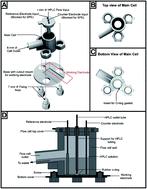当前位置:
X-MOL 学术
›
Anal. Methods
›
论文详情
Our official English website, www.x-mol.net, welcomes your
feedback! (Note: you will need to create a separate account there.)
Versatile additively manufactured (3D printed) wall-jet flow cell for high performance liquid chromatography-amperometric analysis: application to the detection and quantification of new psychoactive substances (NBOMes)
Analytical Methods ( IF 2.7 ) Pub Date : 2020-03-26 , DOI: 10.1039/d0ay00500b Hadil M. Elbardisy 1, 2, 3, 4, 5 , Eduardo M. Richter 1, 2, 3, 4, 6 , Robert D. Crapnell 1, 2, 3, 4 , Michael P. Down 1, 2, 3, 4 , Peter G. Gough 1, 2, 3, 4 , Tarek S. Belal 7, 8, 9, 10, 11 , Wael Talaat 5, 8, 11, 12, 13 , Hoda G. Daabees 8, 11, 12, 13, 14 , Craig E. Banks 1, 2, 3, 4
Analytical Methods ( IF 2.7 ) Pub Date : 2020-03-26 , DOI: 10.1039/d0ay00500b Hadil M. Elbardisy 1, 2, 3, 4, 5 , Eduardo M. Richter 1, 2, 3, 4, 6 , Robert D. Crapnell 1, 2, 3, 4 , Michael P. Down 1, 2, 3, 4 , Peter G. Gough 1, 2, 3, 4 , Tarek S. Belal 7, 8, 9, 10, 11 , Wael Talaat 5, 8, 11, 12, 13 , Hoda G. Daabees 8, 11, 12, 13, 14 , Craig E. Banks 1, 2, 3, 4
Affiliation

|
Additive manufacturing (AM/3D printing) is an emerging technology of vast applicability, receiving significant interest in a plethora of industrial domains and scientific research since it allows the rapid translation of designs produced via computer software, into AM/3D printed objects. To date, AM/3D printed devices have been examined for their utilisation as convenient and cost-effective tools towards the detection and quantification of prevalent drugs of abuse. Herein, a novel AM/3D printed wall-jet flow cell was fabricated specifically for employment in high performance liquid chromatography-amperometric detection (HPLC-AD) of various analytes (New Psychoactive Substances). Five sensing platforms were investigated, utilising different working electrodes, namely; screen-printed graphite electrodes (SPEs), AM/3D Proto-Pasta, AM/3D Black Magic, graphite sheet and AM/3D printed nanographite (NG)/polylactic acid (PLA) towards the detection of New Psychoactive Substances. The flow cell was also optimised with respect to the cell geometry demonstrating significant benefits such as simple production and operation and the ability to tailor the platform to a variety of working electrodes. The AM/3D printed sensing platforms were characterised towards the (electro) analytical detection of four N-benzylmethoxy-derivatives: 25F–NBOMe, 25C–NBOMe, 25B–NBOMe and 25I–NBOMe. Furthermore, the (electro) analytical performance of the flow cell was compared with the findings in our previous work comprising of a commercially available impinging jet flow cell. The SPEs and the graphite sheet were found to demonstrate superior electrochemical (analytical) sensitivity and higher reproducibility towards the quantification of the drugs in question, followed by the NG/PLA AM, Proto-Pasta and the Black Magic. The working electrodes that exhibited satisfactory (electro) analytical responses were employed for the analysis of NBOMe derivatives in three simulated blotter papers.
中文翻译:

用于高性能液相色谱-安培分析的多功能增材制造(3D打印)壁流式流通池:在检测和定量新型精神活性物质(NBOMes)中的应用
增材制造(AM / 3D打印)是一种具有广泛应用性的新兴技术,由于它允许快速翻译通过以下方式产生的设计,因此在众多工业领域和科学研究中引起了极大兴趣计算机软件,转换为AM / 3D打印对象。迄今为止,已经对AM / 3D打印设备的使用进行了检查,以作为方便和具有成本效益的工具来检测和量化流行的滥用药物。在此,专门为各种分析物(新型精神活性物质)的高效液相色谱-安培检测(HPLC-AD)应用而制造了新颖的AM / 3D打印壁喷射流动池。研究了五个感应平台,利用了不同的工作电极。丝网印刷石墨电极(SPEs),AM / 3D原始面食,AM / 3D Black Magic,石墨薄板和AM / 3D印刷的纳米石墨(NG)/聚乳酸(PLA),可用于检测新的精神活性物质。还针对流通池的几何形状对流通池进行了优化,从而证明了其显着的优势,例如生产和操作简单以及为各种工作电极定制平台的能力。AM / 3D打印传感平台的特点是针对四个的(电子)分析检测N-苄基甲氧基衍生物:25F–NBOMe,25C–NBOMe,25B–NBOMe和25I–NBOMe。此外,将流通池的(电)分析性能与我们以前的工作(包括可商购的撞击式射流流通池)中的发现进行了比较。发现SPE和石墨片材表现出优异的电化学(分析)灵敏度和对所涉及药物定量的更高再现性,其次是NG / PLA AM,Proto-Pasta和Black Magic。表现出令人满意的(电)分析响应的工作电极被用于分析三张模拟吸水纸中的NBOMe衍生物。
更新日期:2020-03-26
中文翻译:

用于高性能液相色谱-安培分析的多功能增材制造(3D打印)壁流式流通池:在检测和定量新型精神活性物质(NBOMes)中的应用
增材制造(AM / 3D打印)是一种具有广泛应用性的新兴技术,由于它允许快速翻译通过以下方式产生的设计,因此在众多工业领域和科学研究中引起了极大兴趣计算机软件,转换为AM / 3D打印对象。迄今为止,已经对AM / 3D打印设备的使用进行了检查,以作为方便和具有成本效益的工具来检测和量化流行的滥用药物。在此,专门为各种分析物(新型精神活性物质)的高效液相色谱-安培检测(HPLC-AD)应用而制造了新颖的AM / 3D打印壁喷射流动池。研究了五个感应平台,利用了不同的工作电极。丝网印刷石墨电极(SPEs),AM / 3D原始面食,AM / 3D Black Magic,石墨薄板和AM / 3D印刷的纳米石墨(NG)/聚乳酸(PLA),可用于检测新的精神活性物质。还针对流通池的几何形状对流通池进行了优化,从而证明了其显着的优势,例如生产和操作简单以及为各种工作电极定制平台的能力。AM / 3D打印传感平台的特点是针对四个的(电子)分析检测N-苄基甲氧基衍生物:25F–NBOMe,25C–NBOMe,25B–NBOMe和25I–NBOMe。此外,将流通池的(电)分析性能与我们以前的工作(包括可商购的撞击式射流流通池)中的发现进行了比较。发现SPE和石墨片材表现出优异的电化学(分析)灵敏度和对所涉及药物定量的更高再现性,其次是NG / PLA AM,Proto-Pasta和Black Magic。表现出令人满意的(电)分析响应的工作电极被用于分析三张模拟吸水纸中的NBOMe衍生物。











































 京公网安备 11010802027423号
京公网安备 11010802027423号